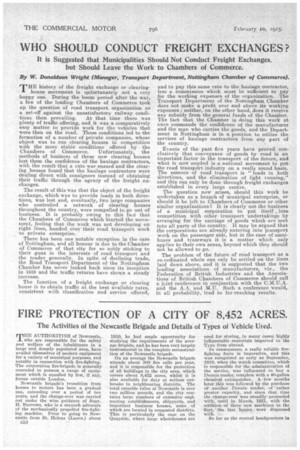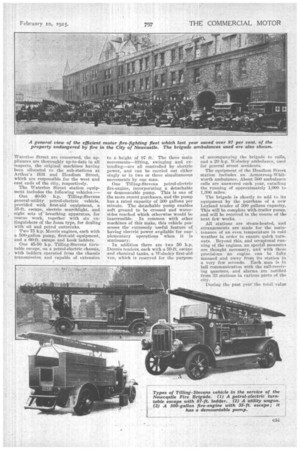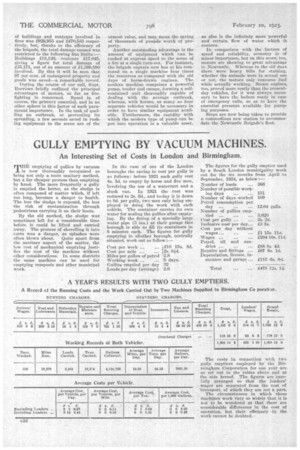FIRE PROTECTION OF A CITY OF 8,452 ACRES.
Page 34

Page 35

Page 36

If you've noticed an error in this article please click here to report it so we can fix it.
The Activities of the Newcastle Brigade and Details of Types of Vehicle Used.
?TIRE AUTHORITIES of Newcastle, .1. who are responsible for the safety and welfare of the inhabitants in a large and densely populated area, have availed themselves of modern equipment for a variety of municipal purposes, and notably in connection with fire-fighting_ The corporation fire-brigade is generally conceded to possess a range of equipment which is equalled by few, if any, forces outside London._ Newcastle brigade's transition from horses to motors has been a gradual one, extending over a period of ten years, and the change-over was carried out under the wise guidance of Supt. H. Burrows, who is a staunch advocate of the mechanically propelled fire-fighting machine. Prior to going to Newcastle from St. Helens (Lancs.) about
c50
1910, he had ample opportunity for studying the requirements of the average brigade, and he has been very largely instrumental in the complete reconstruction of the Newcastle brigade.
On an average the Newcastle brigade attends about 300 fire calls per year, and it is responsible for the protection of all buildings in the city area, which covers about 8,452 acres, whilst it is also available for duty at serious outbreaks in neighbouring districts. The total rateable value of Newcastle is over two million pounds, and the city contains large numbers of extensive engineering establishments, shipyards, and important business houses, some _ of which are located in congested districts. This is particularly the case on the Quayside, where large wherehouses are used for storing, in many cases, highly inflammable materials imported to the Tyne from abroad.
In consequence, a really reliable firefighting force is imperative, and this was recognized as early as September,. 1910, when the watch committee, which "is responsible for the administration of the service, was influenced to buy a Dennis tender, complete with a 40-gallon 'chemical extinguisher. A few months later this was followed by the purchase of. another Dennis tender, of 'rather greater capacity, and since that time the •change-over was-steadily proceeded with, until in March, 1921, with the . addition of three DEW niacbines to the
• fl eet,' the last hoyses were dispensed with. So far as the central headquarters in
Waterloo Street are concerned, the appliances are thooughly up-to-date in all respects, the original machines having been allocated to the sub-stations at Arthur's Rill and Readlam Street, which are responsible for the west and east ends of the city, respectively.
The Waterloo Street station equipment includes the following vehicles:— One 40-50 h.p. Tilling-Stevens general-utility petrol-electric vehicle, provided with first-aid equipment, a 35-ft. escape electric searchlight, and , eight sets of 'breathing apparatus, for rescue work, together with six extinguishers of the foam type, for dealing with oil and petrol outbreaks.
Two 75 h.p. Morris engines, each with a h00-gallon pump, first-aid equipment, and a 60-ft. escape and hook ladders.
One 45-50 h.p. Tilling-Stevens turntable escape, on a petrol-electric chassis, with ladders operated from the chassis transmission and capable of extension to a . height of 87 ft. The three main movements—lifting, swinging and extending—are all controlled by electric power, and can be carried out either singly or in two or three simultaneous movements by one man.
One Tilling-Stevens petrol-electric fire-engine, incorporating a detachable or demountable pump. This is one of the more recent purchases, and the pump has a rated capacity of 300 gallons per minute. The detachable pump enables soft ground to be crossed and watersides reached which otherwise would be inaccessible. In common with other machines of this make, this vehicle possesses the extremely useful feature of having electrie power available for supplementary operations when it is stationary: " • In addition there are two 50 h.p. Dennis tenders, each with a 50-ft. escape and chemical tanks, a Wolseley first-aid van, which is reserved for the purpose
of accompanying the brigade to calls, and a 20 h.p. Wolseley ambulance, used for general street accidents.
The equipment of the Headlara Street station includes an Armstrong--Whitworth ambulance. About 500 ambulance calls are answered each year, entailing the running of •approximately 1,000 to 1,300 miles.
The brigade is shortly to add to its equipment by the purchase of a new Leyland tender of 300 gallons capacity. This will be complete with trailer pump, and will be received, in the course of the next few weeks.
• All stations are steam-heated, and arrangements are made for the maintenance of an even temperature in cold. weather in order to ensure quick turnouts. . Beyond this, and occasional running of the 'engines, no special measures are thought necessary, and with these provisions an engine can be fully manned and away from its station in a very few seconds. Each man is in bell Commtinication with the call-receiving quarters.. and alarms are ThOtified from 33 stations in various parts of the city.
During the past year thetotal value
of buildings and contents involved in fires was £929,955 and £470,535 respectively, but, thanks to the efficiency of the brigade, the total damage caused was restricted to the following fine limits :Buildings 118,126, contents £17,045, giving a figure for total damage of 135,171, out of an amount of £1,399,590 involved. By this it will be seen that 97 per cent, of endangered property and goods was saved-a remarkable record.
1)uring the course of our call, Supt. Burr-ows briefly outlined the principaladvantages of motors, so far as firefighting is concerned. Speed is, of course, the primary essential, and in no other sphere is this factor of such paramount importance. In the task of quelling an outbreak, or preventing its spreading, a few seconds saved in rushing equipment to the scene are of the
utmost value, and may. mean the saving of thousands of pounds wOrth of property.
Another outstanding advantage is the amount of equipment which can be rushed at express speed to the scene of a fire at a single turn-out. For instance, the brigade captain now has at his command on a single machine four times the resources as compared with the old days of horse-drawn engines. The modern machine comprises a powerful pump, tender and escape, forming a selfcontained unit thoroughly capable of dealing with the average outbreak, whereas, with horses, as many as four separate vehicles would be necessary in order to have similar equipment available. Furthermore, the rapidity with which the modern type of pump can be put into operation is a valuable asset, as also is the infinitely more powerful and certain flow of water which it ensures.
In commarison with the factors of speed and reliability, economy is of minor importance, but on this score, too, motors are showing togreat advantage in Newcastle. Whereas in the old days there were heavy bills for stabling, whether the animals were in actual use or not, the motors only consume fuel while actually working. Steam engines, too, proved more costly than the presentday vehicles, for it was always necessary to have the boilers ready in case of emergency calls. so as to have the essential pressure available for pumping purposes.
Steps are now being taken to provide a commodious new station to accommodate the Newcastle Brigade's fleet.














































